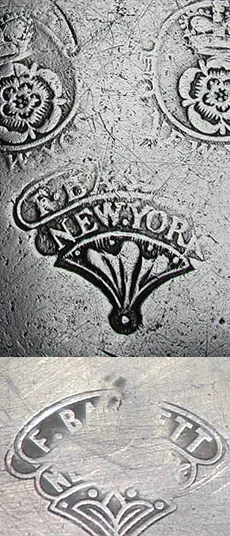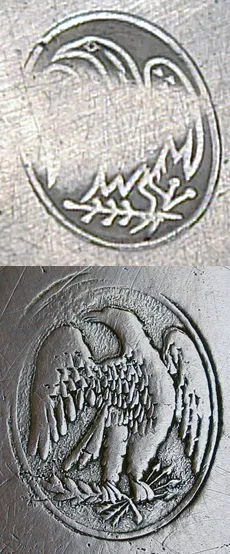Nov 2, 2016
Originally published on: Jun 24, 2013

The real Frederick Bassett marks, top, are more detailed with uneven wear. The fake, bottom, is blocky and flat, showing signs of artificial wear.
(Image of real mark courtesy of Wayne & Phyllis Hilt, Hiltpewter.com)

The fake eagle mark, top, is not typically associated with Frederick Bassett, but most closely resembles the real mark, bottom, of Thomas D. Boardman.
(Image of real mark courtesy of Wayne & Phyllis Hilt, Hiltpewter.com)
"I won't drag this out," Leigh Keno said during his appraisal of a Frederick Bassett pewter inkwell at ANTIQUES ROADSHOW's 1998 appraisal event in Los Angeles, "but one of the things that's good on the show is to learn what a fake is, and this is a fake." No less intrigued by his object, Richard, the owner of a pewter inkwell, was eager to learn more about his piece. He'd brought in a catalogue that included other Frederick Bassett pewter items, conjecturing that his piece fit in stylistically. The mark on his piece displayed "F. Bassett" with a fan design, which meant that it could be associated with highly regarded 18th-century New York pewter maker Frederick Bassett (1740-1800.) It also showed a simple eagle mark, which displayed signs of wear. In order to illustrate Keno's explanation of the difference between the real and fake marks, ANTIQUES ROADSHOW researched examples of these particular designs and has shared them in this feature for consideration.
Keno pointed out several "red flags" associated with this piece. As he showed, seeing and feeling the object helped determine whether or not it was real. While maker's marks were created to help identify different craftsmen and to ensure a piece's authenticity, the designs have been copied to augment value on cheap imitations.
In this case, the Frederick Bassett mark is incorrect for a number of reasons. Keno observes that the fake mark uses a stiff, blocky and flat font, unlike the real version. In researching real versions of these marks to associate with Keno's appraisal, it seems as though the eagle most resembles those featured on the pewter pieces of American maker Thomas D. Boardman (Hartford, CT, 1805 - 1870), not one of Frederick Bassett's marks. "It almost looks like a decal," Keno said, "a very commercial-looking mark."
Both marks on the inkwell show signs of artificial wear, Keno describes. Consistent rubbing dulled part of the imprint, giving it too streamlined an effect in contrast to natural wear, which would be more uneven and haphazard. "It looks like somebody sat there and scrubbed it," Keno said, "and somebody did that to wear away part of that mark."
By looking at the shape of it, Keno said that the inkwell was probably made from the dome of another piece from the early 19th century, to which somebody added the fake marks. Had the piece been real, "it probably would have been worth upwards of $15,000 as a rare Frederick Bassett inkwell because inkwells from early makers like this from the 1770s don't turn up," Keno said. Keno appraised the piece for $250 to $300, a value that has stayed the same 15 years later.





